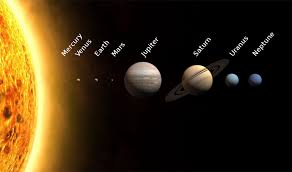Physics – The Solar System – Notes For W.B.C.S Examination.
পদার্থবিজ্ঞান – সৌর সিস্টেম – WBCS পরীক্ষার জন্য নোট।
- The Sun and all the celestial bodies which revolve around it (the sun) are known as the solar system.Continue Reading Physics – The Solar System – Notes For W.B.C.S Examination.
- The solar system consists of a large number of bodies including planets, comets, asteroids, and meteors.
- There are eight planets; they are arranged in their order of distance from the Sun as: Mercury, Venus, Earth, Mars, Jupiter, Saturn, Uranus and Neptune (see the image given below).
- The first four planets, Mercury, Venus, Earth and Mars, are known as ‘inner planets.’
- Jupiter, Saturn, Uranus and Neptune are much farther off from the sun and known as ‘outer planet.’
The Sun
- The Sun is the nearest star from the earth.
- The Sun is about 150,000,000 kilometers (150 million km) away from the Earth.
- The Sun is the source of almost all energy available on the Earth.
- After sun, Alpha Centauri, is the nearest star from the earth.
- Light year is the distance travelled by light in one year.
- The speed of light is about 300,000 km per second.
The Planets
- There are eight planets that keep changing their positions with respect to the stars.
- The planets have definite paths in which they revolve around the Sun.
- The path of the planet is known as an orbit (see the image given above).
- The time taken by a planet to complete one revolution is known as its period of revolution.
- The time period of revolution increases with the distance of the planet increases from the sun.
- All planet also rotates on its own axis, which is known as its rotation period.
- A celestial body revolving around the planet is known as satellite or moon.
- The planet mercury is smallest and nearest to the Sun.
- Mercury has no satellite of its own.
- Venus is the nearest planet to the earth.
- Venus is the brightest planet.
- Venus appears in the eastern sky before sunrise and appears in the western sky after sunset; therefore, it is also known as morning or an evening star.
- Venus has no moon/satellite.
- Venus rotates from east to west.
- From space, earth appears blue-green due to reflection of light from water and landmass accordingly.
- The Earth has one moon.
- Mars appears somewhat reddish and, hence, known as the red planet.
- Mars has two natural satellites.
- Jupiter is the largest planet of the solar system.
- Jupiter is about 318 times heavier than that of the Earth.
- Saturn appears yellowish in color.
- Saturn has rings around it.
- Saturn is the least dense among all the planets (even water is denser than Saturn).
- Like Venus, Uranus also rotates from east to west.
- The most significant feature of Uranus is that it has highly tilted rotational axis.
- There is a large gap between the orbits of Mars and Jupiter; it is filled with some objects known as ‘asteroids’ and this region is known as asteroid belt (see the image given below).
- A Comet appears usually as a bright head with a long tail and the length of the tail grows in size as it approaches towards the sun .
- Halley’s comet appears after (nearly) every 76 years; last seen in 1986.
- A meteor is typically a small object that occasionally enters the earth’s atmosphere.
- Meteors are commonly known as shooting stars.
- Some meteors are very large and they reach the Earth before they evaporate completely.
- The meteor that reaches the Earth is known as meteorite.
Our own publications are available at our webstore (click here).
For Guidance of WBCS (Exe.) Etc. Preliminary , Main Exam and Interview, Study Mat, Mock Test, Guided by WBCS Gr A Officers , Online and Classroom, Call 9674493673, or mail us at – mailus@wbcsmadeeasy.in
Visit our you tube channel WBCSMadeEasy™ You tube Channel
Please subscribe here to get all future updates on this post/page/category/website



 Toll Free 1800 572 9282
Toll Free 1800 572 9282  mailus@wbcsmadeeasy.in
mailus@wbcsmadeeasy.in


















































































































